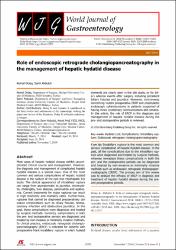| dc.contributor.author | Dolay, Kemal | |
| dc.contributor.author | Akbulut, Sami | |
| dc.date.accessioned | 10.07.201910:49:13 | |
| dc.date.accessioned | 2019-07-10T20:04:38Z | |
| dc.date.available | 10.07.201910:49:13 | |
| dc.date.available | 2019-07-10T20:04:38Z | |
| dc.date.issued | 2014 | en_US |
| dc.identifier.citation | Dolay, K. ve Akbulut, S. (2014). Role of endoscopic retrograde cholangiopancreatography in the management of hepatic hydatid disease. World Journal of Gastroenterology, 20(41), 15253-15261. https://dx.doi.org/10.3748/wjg.v20.i41.15253 | en_US |
| dc.identifier.issn | 1007-9327 | |
| dc.identifier.issn | 2219-2840 | |
| dc.identifier.uri | https://dx.doi.org/10.3748/wjg.v20.i41.15253 | |
| dc.identifier.uri | https://hdl.handle.net/20.500.12511/4083 | |
| dc.description | WOS: 000345115100025 | en_US |
| dc.description | PubMed ID: 25386073 | en_US |
| dc.description.abstract | Most cases of hepatic hydatid disease exhibit uncomplicated clinical course and management. However, the diagnosis and management of complicated hepatic hydatid disease is a special issue. One of the most common and serious complications of hepatic hydatid disease is the rupture of the cyst into intrahepatic bile ducts. The clinical appearance of intrabiliary rupture can range from asymptomatic to jaundice, cholecystitis, cholangitis, liver abscess, pancreatitis and septicemia. Current treatments for major ruptures can result in high morbidity and mortality rates. Furthermore, ruptures that cannot be diagnosed preoperatively can induce complications such as biliary fistulae, biloma, cavitary infection and obstructive jaundice. In the past, these complications were diagnosed and treated by surgical methods. Currently, complications in both the pre- and postoperative periods are diagnosed and treated by non-invasive or minimally invasive methods. In clinical practice, endoscopic retrograde cholangiopancreatography (ERCP) is indicated for patients with preoperative frank intrabiliary rupture in which hydatid elements are clearly seen in the bile ducts, or for biliary adverse events after surgery, including persistent biliary fistulae and jaundice. However, controversy concerning routine preoperative ERCP and prophylactic endoscopic sphincterotomy in patients suspected of having minor cystobiliary communications still remains. In this article, the role of ERCP in the diagnosis and management of hepatic hydatid disease during the pre- and postoperative periods is reviewed. | en_US |
| dc.language.iso | eng | en_US |
| dc.publisher | Baishideng Publishing Group Inc | en_US |
| dc.rights | info:eu-repo/semantics/openAccess | en_US |
| dc.subject | Hydatid Cyst | en_US |
| dc.subject | Complications | en_US |
| dc.subject | Intrabiliary Rupture | en_US |
| dc.subject | Endoscopic Retrograde Cholangiopancreatography | en_US |
| dc.title | Role of endoscopic retrograde cholangiopancreatography in the management of hepatic hydatid disease | en_US |
| dc.type | review | en_US |
| dc.relation.ispartof | World Journal of Gastroenterology | en_US |
| dc.department | İstanbul Medipol Üniversitesi, Tıp Fakültesi, Cerrahi Tıp Bilimleri Bölümü, Genel Cerrahi Ana Bilim Dalı | en_US |
| dc.authorid | 0000-0001-9776-8945 | en_US |
| dc.identifier.volume | 20 | en_US |
| dc.identifier.issue | 41 | en_US |
| dc.identifier.startpage | 15253 | en_US |
| dc.identifier.endpage | 15261 | en_US |
| dc.relation.publicationcategory | Diğer | en_US |
| dc.identifier.doi | 10.3748/wjg.v20.i41.15253 | en_US |
| dc.identifier.wosquality | Q2 | en_US |
| dc.identifier.scopusquality | Q1 | en_US |


















